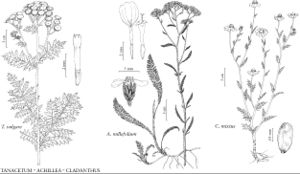Tanacetum
Sp. Pl. 2: 843. 1753.
Gen. Pl. ed. 5, 366. 1754.
| Taxon | Illustrator ⠉ | |
|---|---|---|
 | Tanacetum vulgare Achillea millefolium Cladanthus mixtus | Yevonn Wilson-Ramsey Linny Heagy Yevonn Wilson-Ramsey |
Perennials [annuals, subshrubs], 5–150 cm (usually rhizomatous; usually aromatic). Stems 1 or 2–5+, erect or prostrate to ascending, branched proximally and/or distally, glabrous or hairy (hairs basifixed and/or medifixed, sometimes stellate). Leaves basal and/or cauline; alternate; petiolate or sessile; blades mostly obovate to spatulate, usually 1–3-pinnately lobed, ultimate margins entire, crenate, or dentate, faces glabrous or hairy. Heads usually radiate, sometimes disciform (or quasi-radiate or radiant), usually in lax to dense, corymbiform arrays, rarely borne singly. Involucres mostly hemispheric or broader, (3–) 5–22+ mm diam. Phyllaries persistent, (20–) 30–60+ in (2–) 3–5+ series, distinct, ± ovate to oblong or oblong to lanceolate or lance-linear (sometimes carinate), unequal, margins and apices (pale to dark-brown or blackish) scarious (tips sometimes dilated). Receptacles flat to conic or hemispheric (sometimes hairy), epaleate. Ray-florets usually 10–21+ (pistillate and fertile or neuter; corollas pale-yellow to yellow or white, usually with yellowish bases [pink], laminae oblong to flabellate), sometimes 0 (in disciform or quasi-radiate or radiant heads, peripheral pistillate florets 8–30+; corollas pale-yellow, ± zygomorphic, lobes 3–4, sometimes ± raylike). Disc-florets 60–300+, bisexual, fertile; corollas yellow, tubes ± cylindric, throats narrowly funnelform to campanulate, lobes (4–) 5, ± deltate. Cypselae obconic or ± columnar (circular in cross-section), ribs (4–) 5–10 (–12+), faces usually gland-dotted, sometimes glabrous (pericarps without myxogenic cells or resin sacs, embryo-sac development tetrasporic); pappi usually coroniform, rarely 0 [distinct scales or each pappus an adaxial auricle]. x = 9 (polyploidy).
Distribution
North America, Europe, Asia, n Africa, some species widely cultivated
Discussion
Species 160 (4 in the flora).
Selected References
None.
Key
| 1 | Leaves usually not pinnately lobed (sometimes with 1–4+ lateral lobes near bases of blades), ultimate margins ± crenate | Tanacetum balsamita |
| 1 | Leaves usually 1–3-pinnately lobed, ultimate margins entire or dentate | > 2 |
| 2 | Leaf blades 1–2-pinnately lobed (primary lobes 3–5 pairs, ± ovate), faces (at least abaxial) usually puberulent; ray florets 10–21+ (more in "doubles"), corollas white, laminae 2–8(–12+) mm; pappi 0 or coroniform (0.1–0.2+ mm) | Tanacetum parthenium |
| 2 | Leaf blades 2–3-pinnately lobed (primary lobes 4–24+ pairs, ± oblong to elliptic or linear), faces usually arachno-villous to villous, sometimes glabrescent or glabrous; ray florets 0 or 8–30+, corollas pale yellow to yellow, laminae 1–8+ mm; pappi coroniform (0.1–0.5+ mm) | > 3 |
| 3 | Leaves: faces glabrous or sparsely hairy; heads (disciform) 20–200 in corymbiform arrays; involucres 5–10 mm diam | Tanacetum vulgare |
| 3 | Leaves: faces usually ± villous or arachno-villous to lanate, sometimes glabrescent or glabrate; heads (radiate, quasi-radiant or -radiate, or disciform) (2–)5–12(–20+) in corymbiform arrays or borne singly; involucres 8–22+ mm diam | Tanacetum bipinnatum |
"broader" is not a number.